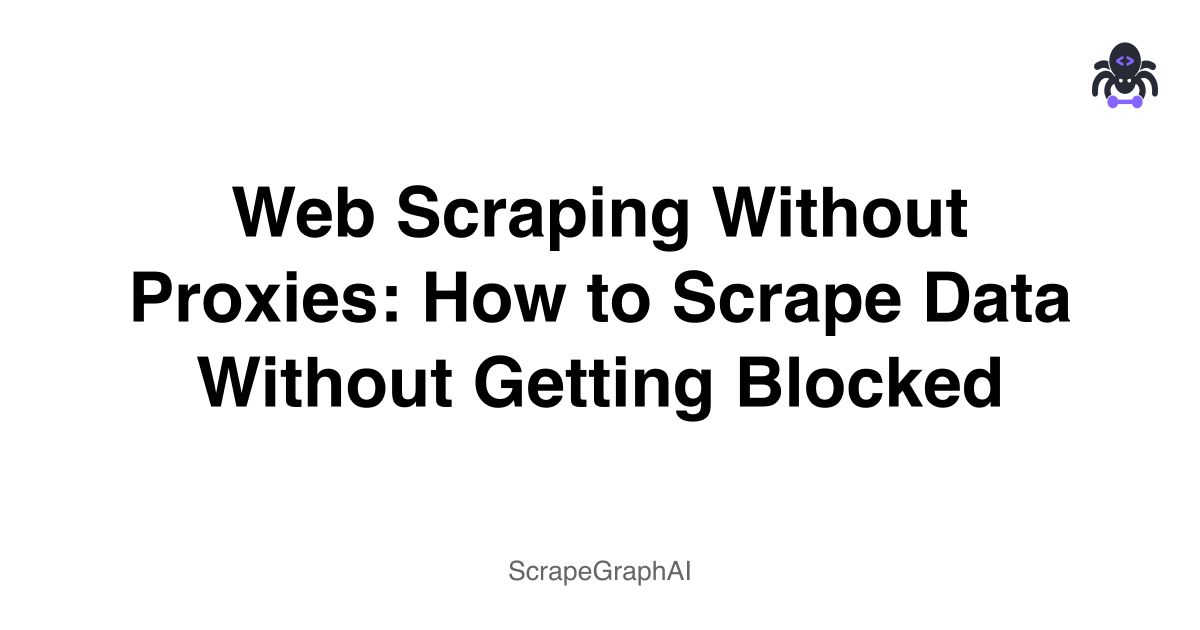Web scraping is one of the most powerful techniques to extract data from websites for analysis, research, or even automating business tasks.
However, when it comes to scraping websites, most people rely on proxies to avoid getting blocked.
But did you know that web scraping without proxies is not only possible but also effective in many cases? In this blog post, we'll explore how you can scrape data without the need for proxies, and still avoid getting flagged as a bot.
1. Understanding Web Scraping Without Proxies
Web scraping without proxies refers to the process of extracting data from a website without using proxy servers to mask your IP address. Instead of rotating proxies or using services like ScraperAPI or ScrapingBee, you rely on other methods to avoid detection. This can be a more straightforward, less resource-intensive approach, especially for smaller-scale scraping tasks.
Benefits of Web Scraping Without Proxies
- Simpler Setup: You don't need to worry about rotating proxies or configuring proxy management systems.
- Faster Execution: Without the need to route traffic through proxies, your requests can be faster.
- Cost-Efficient: Avoid additional costs associated with proxy services.
But how do you ensure your scraping operations remain undetected?
2. Key Techniques for Scraping Without Proxies
Here are some tried-and-true strategies for scraping websites without proxies:
- 1. Respect Rate Limits
Websites often impose rate limits to prevent bots from overwhelming their servers. When scraping without proxies, it's crucial to respect these limits. This means limiting your scraping speed to mimic human-like browsing behavior.
Use random delays between requests to avoid detection:
await page.waitForTimeout(Math.random() * 2000 + 1000); // Random delay between 1s to 3s- 2. Rotate User Agents
Most websites check the User-Agent header to see if requests are coming from legitimate browsers. Rotating User-Agent strings is a great way to avoid getting flagged.
Example of rotating User-Agent in Puppeteer:
await page.setUserAgent('Mozilla/5.0 (Windows NT 10.0; Win64; x64) AppleWebKit/537.36 (KHTML, like Gecko) Chrome/91.0.4472.124 Safari/537.36');- 3. Headless Browsers
Use headless browsers like Puppeteer or Playwright to simulate real user behavior. These tools help you load JavaScript-heavy sites, while providing a much more natural interaction with the site.
Example with Puppeteer:
const browser = await puppeteer.launch({ headless: true });
const page = await browser.newPage();
await page.goto('https://example.com');- 4. Handle CAPTCHAs Manually or Automatically
While it's not always possible to bypass CAPTCHAs without proxies, there are solutions for handling them when scraping without proxies. For example, 2Captcha offers an API that can solve CAPTCHAs automatically, but you may also manually solve CAPTCHAs in some cases.
3. How to Avoid Detection While Scraping Without Proxies
While scraping without proxies can be effective, it does require careful planning. Here are a few tips to ensure your scraping remains undetected:
- 1. Monitor Request Headers
Websites look for patterns in the HTTP request headers to detect bots. Ensure that your headers look like a typical browser request. Set the proper User-Agent, Accept, Accept-Language, and Connection headers to make your request appear more legitimate.
- 2. Handle Cookies Properly
Many websites use cookies to track users and identify suspicious activity. Managing cookies properly by accepting or storing them during scraping can help you mimic a real browsing session.
- 3. Rotate IPs When Necessary
While you are scraping without proxies, you might want to consider rotating your IP occasionally—without fully relying on proxies. This can be done by using different internet connections or through services like VPNs that allow IP rotation.
4. Limitations of Scraping Without Proxies
While scraping without proxies is possible, it does have some limitations. Websites can detect and block IPs that send too many requests, so it's important to be mindful of your scraping rate. Additionally, some websites may have more advanced anti-scraping measures, such as JavaScript challenges, CAPTCHAs, or rate-limiting systems that make scraping without proxies more challenging.
Conclusion
While proxies are often considered a must for effective web scraping, scraping without proxies can be just as powerful if you follow the right techniques. By rotating user agents, respecting rate limits, and utilizing headless browsers, you can successfully scrape data without the need for proxies. However, remember that large-scale scraping or scraping highly-protected sites may still require proxies or additional anti-detection measures.
Start with smaller projects and gradually scale up your operations while fine-tuning your strategies to avoid detection. Happy scraping!
Tired of juggling user agents, rate limits, and anti-detection measures? ScrapeGraphAI handles these complexities for you, turning even challenging scraping tasks into simple API calls. Focus on your data, not the headaches. Give ScrapeGraphAI a try and experience effortless web scraping!
Quick FAQs
Why scrape without proxies?
It's simpler, faster, and more cost-effective for smaller-scale scraping.
When is it not feasible to scrape without proxies?
For large-scale scraping, or if the website has advanced anti-scraping measures (like CAPTCHA or JavaScript-based detection).
What are the best tools for scraping without proxies?
Puppeteer, Playwright, and Selenium are great options that simulate real user behavior.
Related Resources
Want to learn more about proxy-free scraping? Explore these guides:
- Web Scraping 101 - Master the basics of web scraping
- AI Agent Web Scraping - Learn about AI-powered scraping
- Mastering ScrapeGraphAI - Deep dive into our scraping platform
- Building Intelligent Agents - Create powerful automation agents
- Pre-AI to Post-AI Scraping - See how AI has transformed automation
- Structured Output - Learn about data formatting
- Data Innovation - Discover innovative data methods
- Full Stack Development - Build complete data solutions
- Web Scraping Legality - Understand legal considerations
These resources will help you master proxy-free scraping while building powerful solutions.
